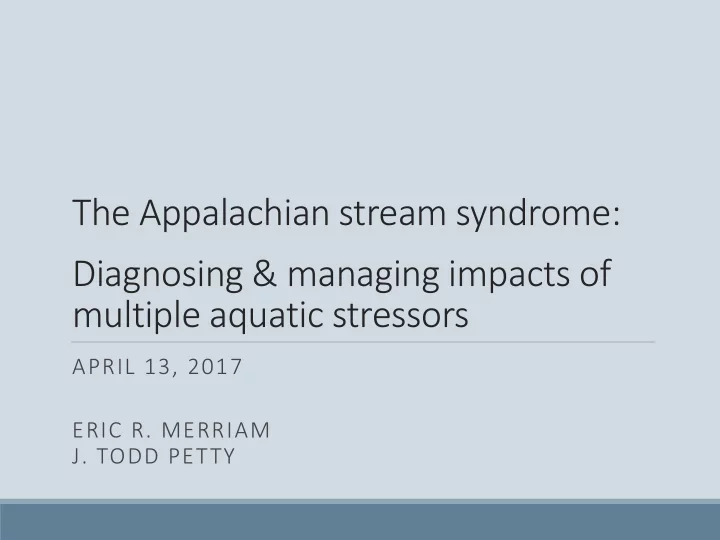

The Appalachian stream syndrome: Diagnosing & managing impacts of multiple aquatic stressors APRIL 13, 2017 ERIC R. MERRIAM J. TODD PETTY
Background & Objectives
Background & Objectives Research objectives: 1. Characterize detailed patterns in chemical degradation 2. Test whether degraded neighborhood conditions affect metacommunity structure (tolerance) and processes (dispersal)
Methods: study area
Methods: in-stream data July–Aug 2010, 11, or 12 Water quality Low flow conditions Physical habitat Quality (RVHA) and complexity Macroinvertebrates Genus-level abundance data Tolerance and dispersal traits
Methods: Landscape data Land cover and use 2011 (July) NAIP imagery Feature extraction Ancillary datasets Deep mine permits Structures Roads Coal geology Temporal consistency between landscape and in-stream datasets
Results: water quality PC 1 PC 2 PC 3
Results: water quality
Results: Neighborhood effects Dev. Explained (72%) CV Dev. (65%) Surface mining Forest PC 1 (mWQ) Dev. Explained (55%) CV Dev. (45%) Neighborhood condition index (NCI) Roads All streams in 5km buffer • Grass/Pasture PC 3 (rWQ) Structures NCI • Sum PCs, standardized by length
Results: neighborhood effects Local
Results: neighborhood effects 80 Optimal local Mod. tolerance Abundance Average local Low dispersal Worst local 60 40 20 0 Predicted abun 2 4 6 100 cNCI 80 Abundanc e 60 40 20 High tolerance High dispersal 0 2 4 6 cNCI
Conclusions Pervasive land use degrades streams via 2 distinct pathways: 1. Degradation of local habitat 2. Degradation of neighborhood condition Patchwork of distinct chemical signatures resulting from multiple natural and anthropogenic factors Pervasive chemical degradation has regional biological implications Isolation effect on moderately sensitive, low dispersing taxa Increased mass effects associated with tolerant taxa
Management implications Need for multi-stressor chemical remediation efforts The capacity for restoration and preservation to maintain regional diversity is limited by neighborhood condition Need strategic management actions that preserve metacommunity processes in the face of uncertain futures Preserve network of undisturbed headwater catchments Restoration should maximize neighborhood improvement
Acknowledgements Dr. Mike Strager Aaron Maxwell Donna Hartman Eric Miller & Alison Anderson
Recommend
More recommend